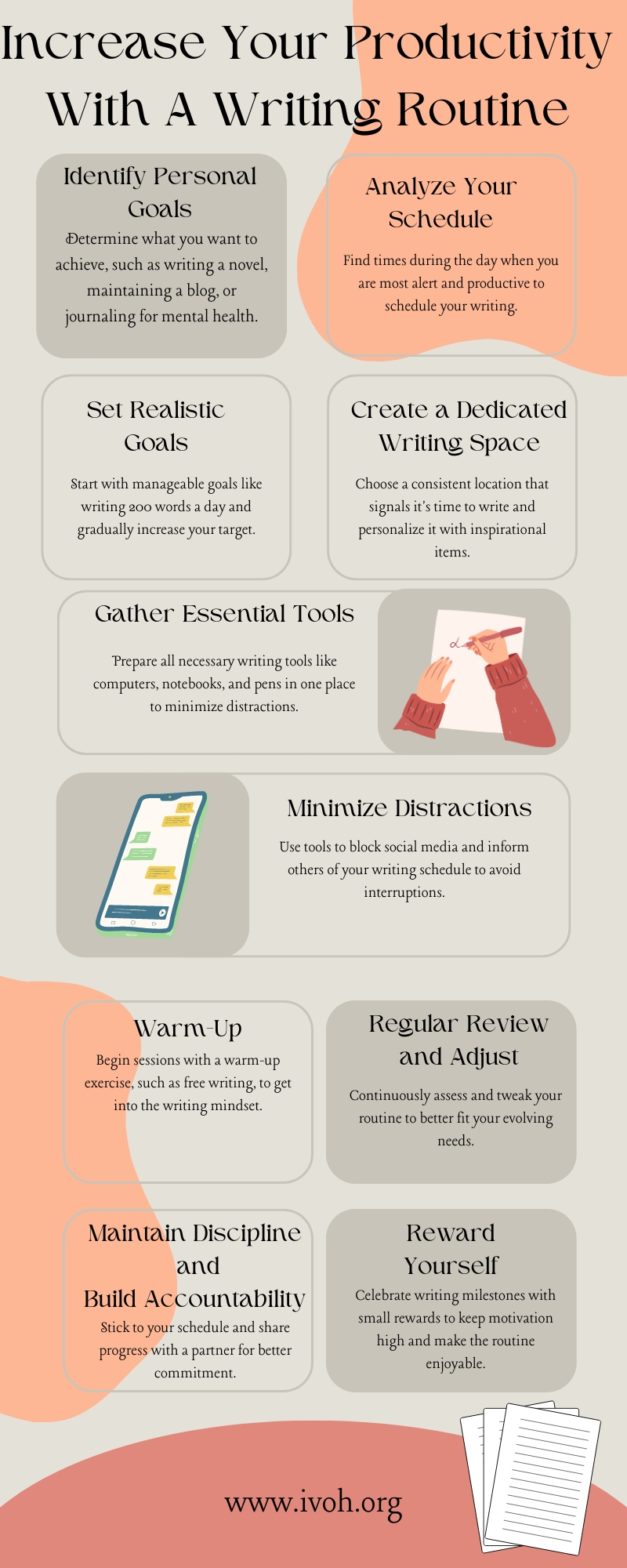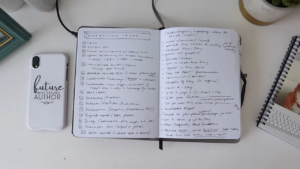Looking to get more out of your writing time? A good writing routine can make a big difference. It not only helps you stay on track but also enhances the quality of your work. We’ll explore simple steps to establish a routine that boosts your productivity, helping you achieve your goals faster and with less stress.
Why You Need a Writing Routine

Regular writing times set a rhythm that can make this activity a natural part of your day. This regularity helps in reducing the resistance to start because it becomes a part of your daily habits. With a routine, you spend less time deciding when to write and more time actually writing.
Increased efficiency can free up more of your day for other important tasks or leisure, enhancing overall life balance. Frequent practice hones your skills, leading to better writing. As you continue in your routine, you may find that your ability to articulate thoughts clearly and creatively is enhanced significantly.
A predictable schedule reduces anxiety about when your next session will be. Knowing exactly when you have planned to write can calm your mind, allowing you to focus on other aspects of life without underlying stress.
First of All – Identifying Your Goals
Before establishing a routine, it’s prudent to fully understand your goals and objectives for writing. Reasons for writing may include long-form work like novels, non-fiction books or plays. Other objectives could involve maintaining a website, blog or social media for personal expression, journalism or business purposes.
Additional goals may encompass academic work like research papers, theses or other assigned projects. journaling and note-taking can also aid self-reflection, decision-making or emotional well-being.
Having clarity around your purpose and intended outcomes helps you customize an efficient routine. Knowing whether you need sustained word counts, article deadlines, revision cycles or other benchmarks allows you to structure your time effectively.
Aligning small daily habits with larger goals keeps you engaged and progressing as intended over weeks and months. Maintaining alignment between objectives and routine also helps identify if changes are needed to obligations or time management as priorities evolve.
Taking time for objective-setting lays the groundwork for a routine tailored to your writing needs. This focused approach helps maximize each creative session and keeps long-term progress on track.
How to Do It?
Step 1: Analyze Your Current Schedule

Take a moment to thoughtfully examine how your days are currently unfolding. Notice when you naturally feel most awake and engaged. For many, this could correlate with the early morning hours or evenings. An awareness of these tendencies can assist you in scheduling dedicated time for writing when your mind is most lively.
Self-knowledge is significant as it prevents attempting creative efforts during phases where motivation or vigor may be lacking. Such awareness helps ensure any sessions you allot are more likely to prove lively and fruitful.
Step 2: Set Realistic Goals
Choose objectives within your means given your available hours and customary pace of expression. Begin with modest, yet fulfilling ambitions, such as crafting 200 words daily, and progressively challenge yourself further as you develop confidence in your process.
This mindful method guarantees you won’t take on more than is prudent, keeping participation in your new regimen viable and satisfying on an ongoing basis. Sustainable habits pave the way for long-term enjoyment and success.
Step 3: Create a Dedicated Writing Space

Designate a devoted workspace. This could take shape as a certain writing desk, a cozy reading nook, or even a favorite table at your neighborhood coffeehouse. The significance lies in routine; let this dedicated area act as a cue to your mind that within its boundaries, it’s time to compose.
Through small touches, imbue the location with warmth and personality. Scribbles of inspiration or a verdant houseplant bring nature indoors, cultivating comfort and providing motivation. Personalizing one’s creative haven in this way enriches the whole endeavor, stoking delight and engagement with each visit.
Step 4: Gather Your Tools
Consider a computer, a writing journal, or an array of pens, along with any books or facts indispensable to your work. Maintaining all necessities together can streamline concentration.
Readiness promises a more fluid shift to creative pursuits, requiring less in the way of lost moments hunting desperately for what you need to proceed. With all in order nearby, downtime dissolves as you immerse inflows of expression unrestrained.
Step 5: Minimize Distractions

This may call for muting mobile devices or using apps to obstruct distracting feeds, focusing your vision inwards. Let close companions know of your dedication in advance so none seek your ear unexpectedly mid-composition.
By cultivating clear agreements with the community, you safeguard your sessions undisturbed. Loved ones respect creative solitude as a necessity, leaving you free to follow imaginings wherever they may lead without glancing over your shoulder wary of each small sound.
Step 6: Warm up (no, Not in a Cardio Exercises Kind of Way)
Before each work session, consider a little tune-up time to loosen the creative muscles. Stretch those thought fibers with a few minutes of free association or brainstorm jottings about your vision ahead.
Getting the mental flow juiced in a low-key way prepares the piping for peak performance once the real plumbing starts. No more clogs or kinks to tangle the torrent of ideas sure to flood forth when fully opened.
Step 7: Regular Review and Adjust

Keep an open eye on how things are flowing with your pattern. Be nimble and ready to tune your schedule, targets, or space depending what the experience teaches. What zips perfectly for a spell may need a retweak down the trail.
Steady updating of the approach makes certain it rides the curves of an ever-morphing lifestyle and craft needs, keeping engagement and success on steady track. By adjusting with the times rather than insisting static plans do the same, this framework evolves as you do – empowering, not bound by, its original contours.
That’s All Fine, but How to Stick to Your Routine?

Discipline is crucial in sticking to any routine. It involves making a commitment to your writing times and goals, regardless of mood or inspiration. Over time, discipline ensures that this activity becomes a habitual part of your life. This consistency is what eventually leads to significant improvements in your work and personal productivity.
Building Accountability
Having someone to report your progress to can greatly enhance your commitment. This could be a writing partner, a coach, or a supportive friend. Accountability partners not only motivate you but can also provide feedback on your work. They serve as a critical sounding board, offering perspectives that can improve your work and help you overcome challenges.
Don’t Forget to Reward Yourself
Set up a reward system to celebrate writing milestones. This could be something as simple as a coffee treat after a week of consistent writing or a new book after completing a big project.
Rewards can boost your motivation and make the routine more enjoyable. These small celebrations mark your progress and remind you of the value of your hard work, reinforcing your commitment to your routine.
Wrapping It Up
Creating and sticking to a writing routine is an ongoing process that evolves as you grow personally and professionally. It’s about discovering what works best for you and using it to unlock your creative potential.
With the right approach, a consistent writing routine can boost your productivity and enrich your writing life.
I’m Anastasia, and I’ve just wrapped up my postgraduate studies in literature. I absolutely love writing books. It’s my way of weaving new worlds and breathing life into the characters that keep me up at night. Literature isn’t just a field of study for me; it’s a canvas where I paint with words. Through my writing, I hope to connect with others who share my love for storytelling and to contribute something meaningful to the literary world.
Related Posts:
- 16 Ways to Describe Emotions Without Making Your…
- A Step-By-Step Guide to Writing Your First Novel -…
- 10 Essentials for Writing Love Scenes - The Writer's Diary
- How To Pick Out Your Genre? Everything You Need to Consider
- 13 Strategies to Promote Your Book on Social Media
- Write a Book Description That Retains Your Readers








